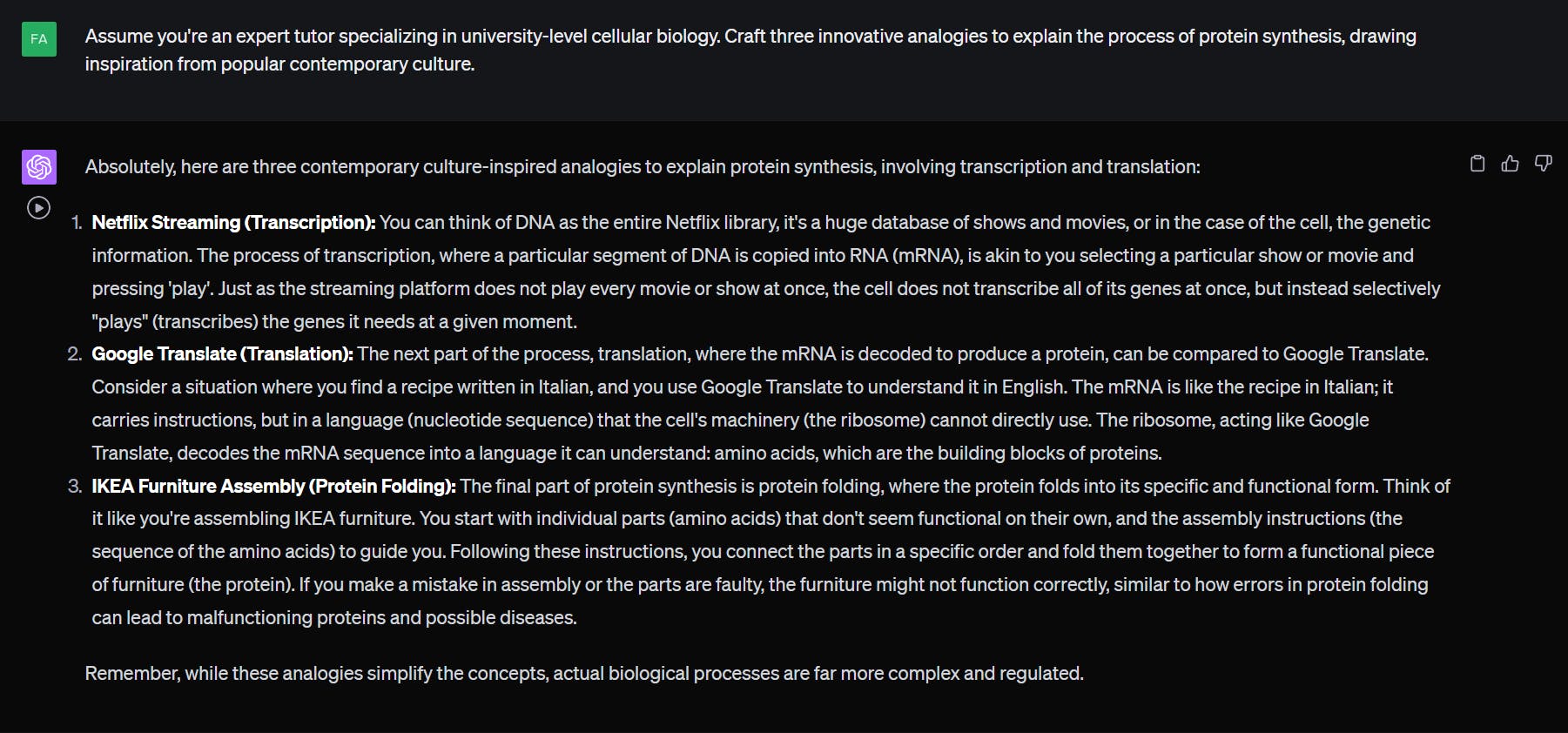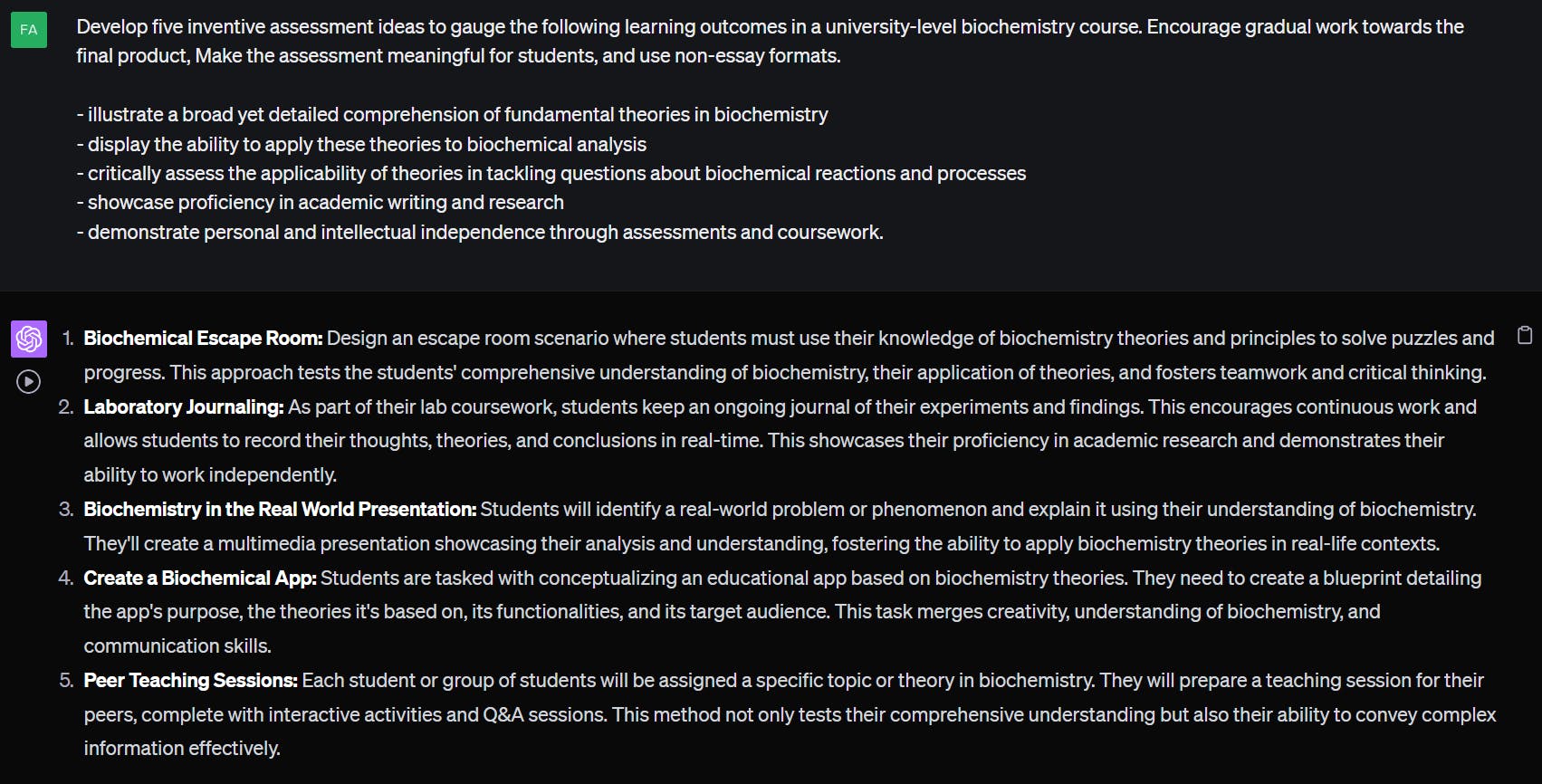And here we are, venturing into Part 2 of our series on generative AI prompt engineering. In the initial segment (PART 1), we looked at the basic principles of prompt engineering, revealing the dynamic interplay between our designed prompts and the responses generated by ChatGPT.
Here are a few more methods to refine your personal approach to prompt engineering.
Exploring Concepts with Analogies and Real-World Scenarios
Understanding complex principles through the lens of everyday situations, such as analogies, can be a game-changer in learning. I have fond memories of my biochemistry professors skillfully spinning intricate concepts into tangible analogies. With AI, you too can effortlessly spin a web of creative analogies to spur your students' curiosity and understanding.
Consider using a prompt like this:
Assume you're an expert tutor specializing in university-level cellular biology. Craft three innovative analogies to explain the process of protein synthesis, drawing inspiration from popular contemporary culture.

If you are an educator and your students have specific interests, tailor this prompt to resonate with them. Perhaps you want the AI to create analogies that reference youtube trends, campus life, or popular movies like the latest DC blockbuster. Remember, the beauty of analogies lies in their imperfections. Dissect these analogies, spotlight their strengths and weaknesses, and propose new analogies or extensions to the existing ones.
Using real-life examples is another robust approach for learning. This method allows users to apply abstract concepts to real-world scenarios, bolstering their motivation and encouraging them to forge connections between different ideas.
Here's a prompt that includes elements of 'RTRI', interwoven throughout:
Assume the role of an expert in evolutionary biology. I am preparing to teach a class about natural selection and evolutionary mechanisms. Provide me with five real-world examples where these principles might be at play - include examples where two different mechanisms are present. Ensure the examples are diverse. Frame these as brief narratives involving various species and ecosystems. Also, identify which evolutionary principle(s) are in action and explain why.

To delve deeper, some of these examples can easily be expanded into more comprehensive case studies by conversing with these models. For instance, you might follow up with a second prompt like this:
Can you expand the first scenario into a more in-depth analysis, including a description of interactions within the ecosystem, and structure it like a case study?
Proposing Innovative Assessment Ideas
Assessments that engage and intrigue students often elicit better results, in terms of both learning and academic honesty. A closer bond between students, teachers, and the assessment tasks themselves can significantly improve academic integrity. And guess what? chatGPT could lend a helping hand here.
This following prompt instructs the chatGPT to devise imaginative assessment ideas aligned with a set of learning outcomes. It also prompts the chatGPT to create assessments that promote steady work progression. In our era of generative AI, the mantra 'assess the journey, not just the destination' is increasingly gaining traction.
Develop five inventive assessment ideas to gauge the following learning outcomes in a university-level biochemistry course. Encourage gradual work towards the final product, Make the assessment meaningful for students, and use non-essay formats.
illustrate a broad yet detailed comprehension of fundamental theories in biochemistry
display the ability to apply these theories to biochemical analysis
critically assess the applicability of theories in tackling questions about biochemical reactions and processes
showcase proficiency in academic writing and research
demonstrate personal and intellectual independence through assessments and coursework.

Once the chatGPT generates these assessment ideas, don't shy away from digging deeper. For instance, you might want the chatGPT to elaborate on specific assessments, elucidating how students could learn most effectively during the assessment process:
Could you outline how the third assessment idea can be structured in a way that maximizes student learning during the completion process?
The chatGPT will then generate some strategies to scaffold the assessment. Remember, its suggestions are by no means flawless; always apply your human expertise and modify as you see fit. Pretty neat ha?
Constructing Assessment Rubrics
Need help with creating a rubric? Generative AIs like chatGPT or google Brad can help you. Rubrics are handy tools designed as grids to help clarify how various levels of proficiency correlate with the grading criteria. They're often presented as tables where the rows signify the criteria, such as analysis of sources, literary usage, critique of arguments, and so on, while the columns indicate standards like High Distinction (HD), Distinction (DI), Credit (CR), Pass (PS), and Fail (FA).
Let's try this prompt, tweaking it according to your subject requirements:
I'm charged with the task of constructing a grading rubric for a first-year university-level evaluation where, as a biology teacher, I am required to assess students' understanding and application of cell biology concepts. Your role is to support me in creating the rubric rows, which define the criteria, while the columns symbolize the grading standards starting from High Distinction, down to Distinction, Credit, Pass, and Fail.
Engage me with relevant questions that will contribute to building an effective rubric. Keep in mind to ask one question at a time, wait for my response patiently, and then proceed to the next question. Once I've responded to all your inquiries, put together a preliminary rubric for me.

The screenshot above shows the questions AI produced. Once I've answered, it generated this rubric.

This prompt encourages AI to question you further to understand your requirements, and then it crafts a basic rubric for you. It's a fascinating prompt as it actively involves the AI asking follow-up questions. The rubric it creates may not be instantly ready for use with students, but it surely provides elements for contemplation and improvement.
While generative AI is an incredibly powerful tool, it's not a replacement for human judgment. Instead, it's a dynamic aid, enhancing our abilities to generate content and drive conversations in unexplored directions. The key is working iteratively with the AI, refining its responses, and ensuring we apply our unique personal insight and expertise to the AI-generated content. However, it's certainly a promising starting point - much better than a blank slate!
This was a 2-part post. if you are interested here is the link for PART 1

